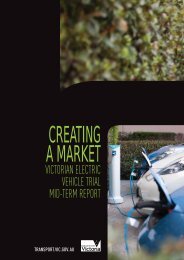Grain Logistics Taskforce Report - Department of Transport
Grain Logistics Taskforce Report - Department of Transport
Grain Logistics Taskforce Report - Department of Transport
Create successful ePaper yourself
Turn your PDF publications into a flip-book with our unique Google optimized e-Paper software.
6.0 Silo to port6.1 <strong>Grain</strong> train availability<strong>Grain</strong> transport requirements aredetermined by the grain marketers.Marketers who can afford to contracttheir own train or trains ($2-3 millionfi xed cost per train as well asoperating costs) primarily use railtransport for their own purposes, butcan sell capacity to other marketerswho buy capacity on a booked orspot basis depending on demand.<strong>Grain</strong> trains in Victoria are primarilyprovided by Pacifi c National (PN)in partnership with <strong>Grain</strong>Corp andEl Zorro in partnership with AWB<strong>Grain</strong>fl ow (Cargill). For the 2011/12grain harvest <strong>Grain</strong>Corp hascontracted with PN for three broadgauge export grain trains,two standard gauge export graintrains and one broad gaugedomestic grain train.Over the same time, El Zorro willbase one broad gauge and twostandard gauge export grain trainsin Victoria. South Australian basedGenesee and Wyoming Australia(GWA), under contract to Viterra,has three standard gauge exportgrain trains primarily for use in SouthAustralia. One <strong>of</strong> the GWA trains isused to transport grain from silosin western Victoria to Port Adelaide,Geelong or Melbourne in accordancewith customer requirements.In total, for the 2011-12 Victoriangrain harvest, there will be nineexport grain trains (four broad gaugeand fi ve standard gauge) and onedomestic grain train (broad gauge)available for use in Victoria. For anexpected 2011 – 12 Victorian grainharvest <strong>of</strong> about six million tonnes,<strong>of</strong> which around 3.5 million tonneswill be exported, PN, El Zorro andGWA’s grain trains could transportaround three million tonnes <strong>of</strong>export grain and 300,000 tonnes<strong>of</strong> domestic grain.Summary <strong>of</strong> Victorian grain trains 2011-12Emerald Group, through its imminentpurchase <strong>of</strong> Australian Bulk Alliance’sgrain assets comprising silos andport capacity, is also negotiating tolease two trains for grain transportfrom southern New South Walesand regional Victoria to the Port <strong>of</strong>Melbourne. This will augment othergrain trains operating in Victoria.<strong>Grain</strong> marketers can also contracttheir own trains to transport grainfrom other companies’ silos.Glencore, for example, in April2011 contracted QR National forthree years in NSW for a bulk trainto transport grain to port from silosaround the State where Glencore haspurchased or stored grain. However,in Victoria the company uses trucksor other companies’ grain trains asrequired because the average graintransport haul in Victoria is abouthalf that <strong>of</strong> NSW (300 kilometrescompared with 600 kilometres).<strong>Grain</strong> marketers who do not havetheir own trains <strong>of</strong>ten contract withtrucking companies because <strong>of</strong>price, convenience, fl exibility or lack<strong>of</strong> availability <strong>of</strong> rail capacity.Government ownership <strong>of</strong> a limitedamount <strong>of</strong> grain rollingstock wassuggested by some as a way <strong>of</strong>augmenting contracted grain trainsat times <strong>of</strong> peak harvest. However,other consultations indicatedthat providing track infrastructurewas maintained to a level whichenabled effi cient grain train cycletimes then the private sector wouldcontract as many grain trainsas required to meet the harvest,assuming rollingstock availability.Operator Export DomesticPacifi c National/<strong>Grain</strong>CorpEl Zorro/AWB <strong>Grain</strong>fl owGWA/Viterra3 broad gauge 1 broad gauge2 standard gauge1 broad gauge2 standard gauge1 standard gauge6.2 Rail network capacityOver the past four years, the Victorian and FederalGovernments, as well as the ARTC, have invested$1.2 billion in improving Victoria’s rail freightinfrastructure. This includes the $73 million upgrade<strong>of</strong> the Geelong to Mildura railway line to improve itsoperational performance for grain and container trainsand $82 million on upgrading and maintaining grainlines in the State’s north-west. There have also beenimprovements in rail access to the ports <strong>of</strong> Melbourne,Geelong and Portland as well as rail capacityimprovements in the critical rail freight corridor inMelbourne’s inner west which is used by interstateand regional freight trains including grain trains goingto and from the Port <strong>of</strong> Melbourne.These investments have signifi cantly improved thefreight capability <strong>of</strong> Victoria’s interstate and regionalrail networks, which has facilitated reduced grain traincycle times. For example, a grain train cycle time <strong>of</strong>36 hours from silo to port and return will enable thetrain to transport 300,000 tonnes <strong>of</strong> grain per annum.A train cycle time <strong>of</strong> 24 hours can increase the train’sproductivity to 500,000 tonnes per annum. However,improved grain train productivity is not just dependenton improved rail infrastructure. It also requiresimprovements to the train loading capability <strong>of</strong> silosand silo opening hours, which are the responsibilities<strong>of</strong> silo operators.The rail network improvements proposed in Appendix Awill enable 36 hour train cycle times to be achieved morereliably and consistently as well as reduce 48 hour graintrain cycle times to 36 hours for a 25% improvement intrain productivity.V/Line, Victoria’s regional track manager, workswith rail freight customers to address their train pathrequirements and other issues in order to improve trainoperating effi ciency. Generally, V/Line considers thatthere is adequate capacity on the regional rail networkfor existing and potential rail freight fl ows.However, Victoria’s two major grain train operators,Pacifi c National and El Zorro, and their major customers,<strong>Grain</strong>Corp and AWB <strong>Grain</strong>fl ow, have expressed concernabout the ability <strong>of</strong> parts <strong>of</strong> Victoria’s regional railnetwork to handle the grain task. For example, there areconcerns about the potential for delays to grain trainsbetween Maryborough and Warrenheip, 10 kilometreseast <strong>of</strong> Ballarat, because there are no crossing loops inthat 75 kilometre section. The concern arises becausethis section <strong>of</strong> track will be used by up to fi ve grain trainsduring the grain harvest in addition to Merbein containertrains and Maryborough passenger trains.Delays to grain trains cause delays to the entire grainsupply chain through delays to grain clearance atsilos which affects harvest clearing with consequentdelays to grain ships at ports. In turn, this can lead toincreased truck use for grain transport to port to meetshipping schedules. Increased train cycle times dueto infrastructure constraints reduces train productivitywhich increases costs to growers from decreased trainproductivity and increased train operating costs.<strong>Grain</strong> <strong>Logistics</strong> <strong>Taskforce</strong> <strong>Report</strong> 19
















